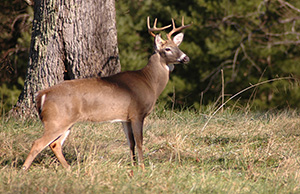
Once the family estate of Admiral Jacob Hugg, a founder of the town of Sykesville in Carroll County, Hugg-Thomas WMA consists of 275 acres in two separate parcels of land separated by Forsythe Road. On the parcel north of Forsythe Road you can visit the ruins of the 19th century Hugg mansion.
Management
Hugg-Thomas WMA is managed by the Wildlife and Heritage Service. The mission of the Wildlife and Heritage Service is to conserve and enhance diverse wildlife populations and associated habitats while providing for public enjoyment of the State’s wildlife resources through hunting and other wildlife-dependent recreation. Hugg-Thomas WMA contains trails available for use by hikers and hunters that are not regularly maintained and are often rough, muddy and steep. This area provides habitat for upland and forest wildlife species including white-tailed deer, wild turkeys, squirrels, and songbirds. Approximately twelve acres of fields are managed as food plots for deer, turkeys, mourning doves, and pollinators. The remainder of the property is forested primarily with oak, hickory and yellow poplar. The northern border of the property is formed by the Patapsco River.
Regulations for All Users
Unless otherwise posted or with a permit issued by the Service it is UNLAWFUL to:
- Operate or possess a vehicle on roads, trails, or waterways not open to general traffic.
- Bait or feed wildlife.
- Use or construct permanent blinds or tree stands. All portable blinds or stands must be removed at the end of the day.
- Ignite, cause to be ignited, or maintain a fire.
- Camp
- Remove, disturb, damage, or destroy a mineral, plant, rock, tree, or nongame animal.
- Have dogs off leash from April 15 through August 15.
- Use dogs to chase fox and raccoons.
- Release any animal or plant.
- Conduct commercial activities.
- Place a cache for the purpose of geocaching.
- Operate, possess, or use combustibles, explosives, or fireworks.
- Dig for relics and treasures, remove prehistoric or historic artifacts, or use a metal detector without a permit from the Office of Archeology.
- Deposit litter or refuse including, but not limited to, animal carcasses, appliances, brush, debris, furniture, garbage, hazardous material, tires, waste paper, yard waste, or other litter.
- Vandalize real property including any blind, building, crop, equipment, gate, habitat, plant, road, sign, trail, vehicle, vessel, or other public property.
- Graze cattle, goats, horses, sheep, or other domestic animals.
- Place decoys prior to 1 hour before legal shooting hours, leave decoys overnight, or remove decoys later than 1 hour after legal shooting hours.
- Target shoot.
Hunting
Public hunting on Hugg-Thomas WMA is permitted during legal hunting seasons with restrictions (see below). A free permit is required and available from the DNR Wildlife and Heritage Service Gwynnbrook Wildlife Office or online. Hunting is available for all legal game species in accordance with current hunting laws and regulations established by the Maryland Department of Natural Resources.
- Hunting access is restricted to seasonal permit holders from September 1st through February 28th and during the Spring Turkey Season.
- Reservations are ONLY required to hunt deer during a deer Muzzleloader or Firearms Season. During these times there are 8 reservations available per day. Reservations are not required for Junior Deer Hunt days or primitive deer hunt days.
- Hunting is permitted Monday through Saturday. No hunting is allowed on Sundays.
- The opening day of Deer Firearms Season is drawn by lottery.
- Permitted hunting devices include all legal devices allowed in Howard County.
- During Spring Turkey Season, hunters must sign in at the parking lot with their Free Public Hunting Permit. Five hunters may sign in at a time.
- Some provisions exist for licensed vehicle use on trails for hunters with a Universal Disability Pass. Contact the Gwynnbrook Wildlife Office at 410-356-9272 for more information.
- Trapping is allowed by permit only. Contact the Gwynnbrook Wildlife Office at 410-356-9272 for more information.
Non-Hunting Users
From September through January and during the Spring Turkey Season, non-hunting users may access the property on Sundays only. No permit or reservation is needed. Outside these timeframes, Hugg-Thomas WMA is open Sunday through Saturday for the following activities:
- Hiking
- Fishing
- Biking on established trails
- Bird Watching
- Nature Photography
- Dogs must be leashed from April 15 through August 15
Directions
Hugg-Thomas WMA is located along the border of Carroll and Howard Counties off MD Route 32, north of U.S. Route 70. Take Exit 80 from Route 70 to MD 32 (Sykesville Road). Parking is located on Forsythe Road. For additional information, contact the Gwynnbrook Wildlife Office at 410-356-9272.
Photograph by Steve Edwards